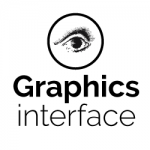Professor Booth is receiving the CHCCS/SCDHM Achievement Award for his long-term contributions to the development of computer graphics, visualisation, and human-computer interaction in Canada. Booth has championed interdisciplinary activities between computer graphics and other areas of research, and he has encouraged cooperation, collegiality and communication among computer graphics researchers and students across Canada. Professor Booth has provided over three decades of thoughtful, dedicated, selfless leadership and service to the HCI and computer graphics community. This is particularly evident in his inspired leadership role in institutions and organizations that have played an instrumental role in shaping the landscape of Canadian computer graphics and HCI research. His scholarly activity demonstrates an exceptional committment to interdisciplinary research. Professor Booth’s research interests are broad. He is one of the few people who has published in at least three different fields, namely theory, graphics, and HCI.
Kellogg Booth holds a professorship at the University of British Columbia, to which he came after serving on the faculty of the University of Waterloo from 1977 through 1990. Along with John Beatty, he was responsible for establishing one of Canada’s preeminent Computer Graphics Laboratories at the University of Waterloo, as well as the Department of Computer Science’s computer graphics curriculum. At the University of British Columbia he helped establish the Imager Laboratory for Graphics, Visualization and HCI at UBC with Alain Fournier and others, a group which has since grown to encompass 10+ faculty. He served from 1990 through 2002 as the founding director of MAGIC, the Media and Graphics Interdisciplinary Centre, beginning his role as a pioneer in HCI in Canada, a stalwart promotor of interdisciplinary research, and a mentor to many large-scale HCI projects spanning disciplines and universities. Professor Booth also participated in the successful multi-million dollar CFI proposal to build the new lab space for ICICS, the Institute for Computing, Information and Cognitive Systems. This is UBC’s premier interdisciplinary research institute in computing, fostering a human-centred approach to emerging information technologies. More recently, from 2004 until 2008, Professor Booth has been the Associate Director, and Acting Director in the first half of 2006, of NECTAR, the Network for Effective Collaboration Technologies through Advanced Research, a Canadian-wide NSERC strategic research network focused on collaboration technologies.
Professor Booth co-chaired the 1983 SIGGRAPH Conference. He has served as the SIGGRAPH Chair and has been involved in this organization since the late 1970’s. Moreover, Professor Booth has almost single-handedly been the key organizational force behind the Graphics Interface conferences in recent years. This has played a large role in promoting the international image for Canada in the areas of HCI and computer graphics. Since 2002, he has served as president of the Canadian Human-Computer Communications Society, the umbrella organization for the annual Graphics Interface conference. He was local arrangements co-chair for the CHCCS conference in 1981, general co-chair of AI/GI/VI in 1992, and general chair of AI/GI/CRV in 2005.
Professor Booth received a B.Sc. in Mathematics from the California Institute of Technology in 1968 and an M.A. and Ph.D. in Computer Science from the University of California at Berkeley in 1970 and 1975, respectively. During his studies, and before entering Canada to take his position at Waterloo, Professor Booth was a staff member at Lawrence Livermore National Laboratory from 1968 to 1976, where he had some of his early exposure to computer graphics.
Professor Booth’s Ph.D. work and early research were in the theoretical areas of computational complexity and graph theory, but at Waterloo he began to focus his interests on graphics rendering and the hardware and software needed for their support. To this gradually became added issues of human-computer interaction and the visual aspects of human interfaces. He has completed over 90 refereed publications, has written over 40 other technical works, and edited two tutorial books of collected articles. He has mentored 16 Ph.D. candidates to the completion of their degrees and supervised over 50 successful Master’s students.
This outline and these numbers do not do justice to the multidisciplinary nature of Professor Booth’s research. A notable project undertaken during the 1980’s with Rhonda Ryman and John Beatty developed an intelligent editor for Benesh Movement Notation, widely used by choreologists even today and maintained by the Royal Academy of Dance. During the 1980’s as well, Professor Booth published a number of early studies on the efficacy of using multitasking and multiprocess hardware and software support for interactive programs, notably the Benesh editor and paint programs. He worked on the leading edge of exploring what hardware would most effectively support graphics rendering, and he helped pioneer the application of controlled experimental design and experimental test-beds from psychology to the study of visual and behavioral aspects of human-computer interaction. These tools were used to investigate such issues as menu layout and placement, the value of anti-aliasing in displays, and comparative approaches to 3D design manipulation via 2D displays. During the 1990’s his interests broadened to include studies in collaborative activities on computers. Publications from this time include topics in virtual and augmented reality, group collaboration at a distance, and device and display issues for cooperative interaction.
Professor Booth’s research continues in the 2000’s along these paths. He is one of the leaders in the testing, assessing, and evaluation of human-computer interaction techniques. Together with his students, he has tackled a broad range of topics in HCI, collaborative technologies, and related areas. Examples of his more recent research include:
- designing affect into physical user interfaces
- input control in large-display and multi-display environments
- privacy-ware for multi-display environments
- structured annotations to support collaborative writing
- tools to support project memory in software development
- personalized user interfaces for heavily-featured software applications
- shared input control for children in an educational setting
Altogether, his work has significantly helped to promote the international image of Canada as a hotbed of HCI. It is also fair to say that the presence of both the University of Waterloo and the University of British Columbia in Canadian computer graphics is owed significantly to Professor Booth’s efforts and presence at these institutions. More broadly, Professor Booth has been the natural person to turn to for many in the community. Whenever an astute, considered opinion is required with regard to establishing and funding large-scale research projects, he has long been a source of wisdom and good judgement.





